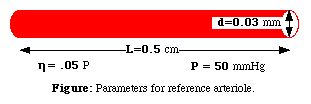|
|
Poiseuille's Law: Typical Parameter ValuesPressure Drop: The complete circulatory system has a mean pressure drop of approximately 100 mmHg. The arterioles comprise 40%-60% of this decrease. Viscosity: Blood plasma has a viscosity of about 0.012 P, but with the red blood cells, this rises to around 0.05 P. This depends on the hematocrit ratio (typically 45%), the percentage of total blood volume composed of red blood cells. Radius: Typical diameters of arterioles are 30 micrometers (0.03 mm). The radius is half this value. However, these diameters are adjustable in order to quickly change the amount of blood that can flow. Length: An approximate length of a arteriole is 0.3-0.5 cm. For future comparisons, we will define our standard arteriole to match
the following schematic:
|

 The growing parabola shows how far blood has advanced in the tube as a
function of distance from the center. The spinning dial shows how much total
blood volume has moved through the tube at the time.
The growing parabola shows how far blood has advanced in the tube as a
function of distance from the center. The spinning dial shows how much total
blood volume has moved through the tube at the time.